
Last bike trip August 2002
Revised April 2003
Directions to Bicycle from Salzburg, to Munich, Innsbruck Austria and Germany
You will cycle mainly on bike paths and minor roads, primarily along the German Alpine Road, in Bavaria.
An excellent-rated continuation is possible from Füssen, Germany over the Fern and Reschen Passes (with shuttles if desired) to Northern Italy
Bike Rating: Very Good
Nature of the Ride: These mainly easy to moderate rides mainly follows the famous (and ill-defined) "German Alpine Road", along the edge of the Austrian and German Alps. The Alps and pre-Alps provide a handsome backdrop to your journey, while you actually ride on flat, slightly sloped, or rolling valley terrain. Beautiful lakes, broad, rushing rivers and mountain resorts punctuate your visit. Incredible castles, created by King Ludwig II of Bavaria, leave lasting impressions of a bygone era.
Below: Salzburg***.
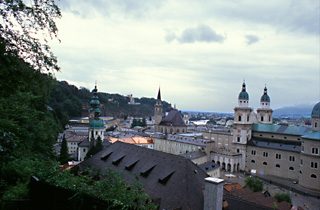 If
you have already seen parts of Europe by bicycle, you probably will
not want to make these routes a bicycling only experience: In the
author's opinion, the landscape along the roads and bicycle paths
is sufficiently interesting and varied for only a few days of riding.
Rather, for a great vacation, combine your cycling with boat trips
on delightful and famous lakes, with hikes into the mountains, with
town sightseeing on foot, with tours of the fairy-tale castles,
and with a concert or two in Salzburg.
If
you have already seen parts of Europe by bicycle, you probably will
not want to make these routes a bicycling only experience: In the
author's opinion, the landscape along the roads and bicycle paths
is sufficiently interesting and varied for only a few days of riding.
Rather, for a great vacation, combine your cycling with boat trips
on delightful and famous lakes, with hikes into the mountains, with
town sightseeing on foot, with tours of the fairy-tale castles,
and with a concert or two in Salzburg.
As you ride along the roads and bike paths the countryside may remind
you of New England or the Mid_Atlantic USA, with woods and forests,
ponds, and scattered farms. The details, however, all differ, and
so does the distant backdrop that you glimpse from time to time:
the Alps.
Germanic Culture enfolds you: schnitzels, strudels, dark bread and great beer at meals, and sturdy well-built houses and hotels, typically decorated inside with white walls and timber trimmings, and occasionally painted on the exterior or bedecked in window boxes full of flowers. Low-backed chairs and benches of light wood, covered with pink-salmon or light green cushions, and of spaciously separated wooden tables, illuminated by overhead, dangling, lighting fixtures forms the interior decor of restaurants..
You bike mainly on bicycle paths, that, particularly in Austria or near the Austrian border in Germany, may suddenly end —to the author it seems almost without rhyme or reason—so also on roads or highways that may have moderate to heavy summer holiday traffic. So you need to feel comfortable riding in traffic, even though you will ride in it rarely.
Below: Road and guest houses above Berchtsgaden**,
Germany
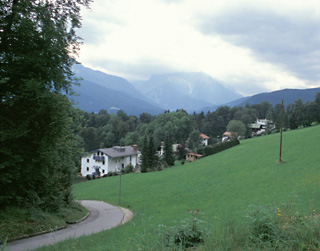 The
normally-smoth pavement of the cycle paths may come to an end (also
without apparent reason), becoming a gravel-surfaced or pebble-surfaced
path. You will need a sturdy bicycle with at least 28 mm tires.
You will find your cycling speed is reduced by one-half on the gravel.
The
normally-smoth pavement of the cycle paths may come to an end (also
without apparent reason), becoming a gravel-surfaced or pebble-surfaced
path. You will need a sturdy bicycle with at least 28 mm tires.
You will find your cycling speed is reduced by one-half on the gravel.
There are several intersecting long-distance bike routes that cross the region. These routes have signposting that ranges from fair to excellent, but, in any event, the signs are small, and on your trip it is likely that you will become lost a few times. Fortunately, in the author's experience, the numerous local bikers are quite helpful and speak English. Pedestrians are helpful too, but may not know the bike routes. Maps, even biking maps, don't necessarily have the scale to help you.
When to Go: May to October. The best chance for dry weather, but also for heat waves, in the summer. August is the height of the tourist season, and in some towns you may not be able to find accommodation at all, or in your price range. August 15 is the holiday of the Assumption in mainly Catholic Bavaria, and accommodations can be particularly hard to get.
Attractions: The biggest tourist attractions along these routes, are the three castles of the mad Bavarian king, Ludwig II.
Below: Neuschwnastein**, viewed from the facing mountain.
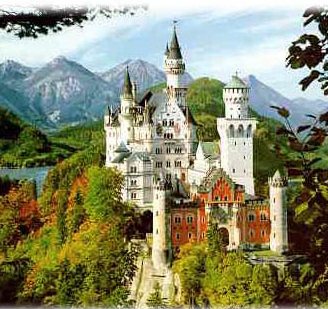 The
most famous one, Neuschwanstein**, is the castle, perched on a spire
above a valley, that you have seen featured on countless jigsaw
puzzles. The photos are all taken from a mountainside where you
are unlikely to go (unless you make a special 2 hour hike), so the
views that you actually see are less striking, but still well worth
seeing. The inside is well worth visiting, but there can be a wait
of an hour or more later in the day, so do arrive early. If you
stay in the area, at Schwangau or Füssen, this should be no
problem. When you visit, take the 15 minute walk behind the castle
around to a bridge, from which you can take an excellent photograph.
Neuschwanstein is reached in the second week of the itinerary given
here.
The
most famous one, Neuschwanstein**, is the castle, perched on a spire
above a valley, that you have seen featured on countless jigsaw
puzzles. The photos are all taken from a mountainside where you
are unlikely to go (unless you make a special 2 hour hike), so the
views that you actually see are less striking, but still well worth
seeing. The inside is well worth visiting, but there can be a wait
of an hour or more later in the day, so do arrive early. If you
stay in the area, at Schwangau or Füssen, this should be no
problem. When you visit, take the 15 minute walk behind the castle
around to a bridge, from which you can take an excellent photograph.
Neuschwanstein is reached in the second week of the itinerary given
here.
Nearby Neuschwanstein** is Schwangau*, a castle built by Ludwig's father, that is also worth visiting while you are in the area.
The second most famous of Ludwig's castles is called "Schloss Herrenchiemsee"**, and you will pass near it on all of the suggested itineraries. It is an "over the top", unfinished, smaller copy of Versailles. King Ludwig figuratively "worshiped the ground" walked on by the Sun King, Louis XIV of France. This castle has some of the most ornate, Versailles-like rooms you'll ever see, filled with copies of the art work of Versailles and portraits of King Louis XIV. But to visit, you'll have to take a short boat ride into the middle of the Chiemsee lake, leaving your locked bicycle behind. Then you will walk about 15 minutes from the dock of the "men's" island through the woods to the castle. Incidentally, the mad king spent a fortune to build it (he didn't have enough funds to complete it), but only spent 10 days there, and never invited any guests at all.
Below: On the Herreninsel** in the Chiemsee**, Ludwig's copy of Versailles
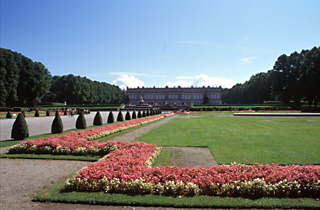 The
same lake has another island, the Fraueninsel, that's worth a visit
while you are at it, and depending on where you take your boat,
may cost nothing more..
The
same lake has another island, the Fraueninsel, that's worth a visit
while you are at it, and depending on where you take your boat,
may cost nothing more..
The third of the mad king's castles is the Linderhof*; this is also filled with references to the Sun King. It is a much more livable castle, but King Ludwig II visited only once or twice. It is a detour of 20 kilometers each way off the itinerary, and could be skipped if you have seen Herrenchiemsee and will see Neuschwanstein, but if you are interested in castles it does complete the story. Nearby is Oberammergau*, an attractive town, well-known for it Passion Play performed from May to September every ten years (in years ending with 0).
The starting point of this trip, Salzburg***, was the birth place of Mozart, and where he lived his early life. The Mozart birthplace house was mainly destroyed by an errant bomb at the end of the Second World War, but has been restored. The old city is on UNESCO's registry of architectural treasures. There are many sights, worth at least a day of touring on foot. In August the Mozart Festival has many musical events every day, and it becomes difficult to obtain a hotel reservation.
One ending point of this bike tour, Munich*** Germany, has many museums, including especially the Alte Pinakothek*** (Old Art Gallery), and the Frauenkirche** (the Church of Our Lady). There are some charming, artistic neighborhoods, such as Schwabing, and some seedy neighborhoods as well, such as the one just south of the main railway station.
Below: The Inn river and Innsbruck***.
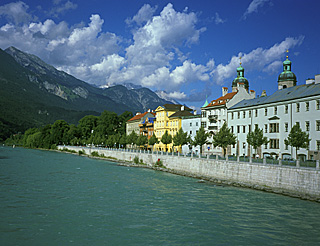 A
second suggested ending point, Innsbruck***, Austria, is a very
charming small city of great authenticity, nestled in a mountain
valley. If you are ambitious, and have the time before you, you
can continue your tour by bicycling over the Brennerpass, 33 kilometers
away, into northern Italy—near or into the Dolomite*** mountains,
or on to Lake Guarda*** and Verona***.
A
second suggested ending point, Innsbruck***, Austria, is a very
charming small city of great authenticity, nestled in a mountain
valley. If you are ambitious, and have the time before you, you
can continue your tour by bicycling over the Brennerpass, 33 kilometers
away, into northern Italy—near or into the Dolomite*** mountains,
or on to Lake Guarda*** and Verona***.
If you make the entire cycle tour across southern Bavaria, you will end at Lindau** on the Bodensee*** (lake). Lindau is a tiny town of character on an island connected to the mainland by a bridge.. From here you can continue biking along the Bodensee circuit, described on this site, and from there to the Rhine and Alsace, France. If you ride that far, you will have crossed all of Southern Germany.
Other Attractions worth of mention on this tour include Berchtesgaden**, a very charming mountain town worth a several days stay, as you visit the nearby attractions. One is the Königssee** lake, Bavaria's wildest and most romantic (but don't expect American style wilderness at all), where you will want to take a boat trip to the Chapel of St. Bartholomä, hike in the forest, and perhaps even take the ski lift to a viewpoint high over the lake. While staying in Berchtesgaden**, you may wish to bike up to Obersalzberg, where Hitler had a private domain, and continue to the nearby Kehlstein**, with the famous "Eagle's Nest". You can climb further on the Rossfeldringstrasse**, a toll road to sensational viewpoints.
The Chiemsee (see means lake) has some charming resort towns along its eastern, northern and western shores, such as Prien, Chieming, and Seebrück. The most frequent and least costly boat services to the Herren and Frauen islands mentioned above are from Prien and from Gstadt.
The towns of Bad Reichenhall and Bad Tölz are both charming, with painted houses on wide streets.
And finally, you may care to visit the two alpine resorts of Garmisch-Partenkirchen and Mittenwald. From Garmisch, the famous and expensive cog-rail carries you up to the Zugspitze***, at over 9,700 feet, Germany's highest point. Other tours by foot, lift, or mountain bike visit make pleasing day outings. Mittenwald*, has fewer lifts and activities, but is more authentic, with old painted houses.
How to
Bike it: Organize the trip yourself. The author is not personally
aware of any English language commercial trips in the region.
Clicking on any photo in this column enlarges it.Clicking on a red bar under a photo gives a bigger enlargement. |
|
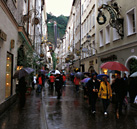 |
|
Street in the old city, Salzburg, Austria. |
|
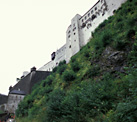 |
|
Salzburg Fort dominates the old city. |
|
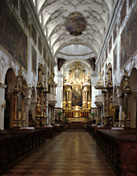 |
|
Saint Peter's church in Salzburg |
|
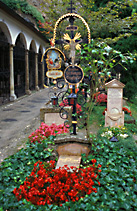 |
|
Cemetery behind Saint Peter's. |
|
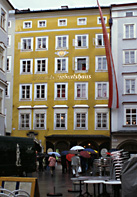 |
|
Mozart's birth-house, Salzburg. |
|
 |
|
View of Berchtesgaden, Bavaria, Germany from the hillside. |
|
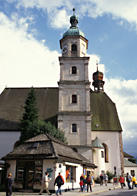 |
|
Berchtesgaden church. |
|
 |
|
View over the beautiful Konigssee. |
|
 |
|
Lovely foret filters Konigssee light. |
|
 |
|
View of Bavarian Alps from near Pidding. |
|
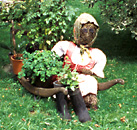 |
|
Scarecrow seen near a village along the route. |
|
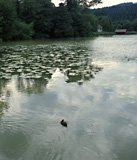 |
|
One of several ponds along the Salz bike itinerary. |
|
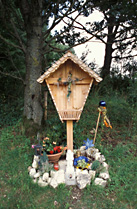 |
|
Grave for a child, near the bike way. |
|
 |
|
Pole of the different town trades, near Traunstein. |
|
 |
|
High Bavarian Alps, behind the Chiemsee |
|
 |
|
Bikers, along the Chiemsee. |
|
 |
|
Town of Seebruck on the Chiemsee. |
|
 |
|
Fountain before Ludwig's castle on the Herreninsel in the Chiemsee. |
|
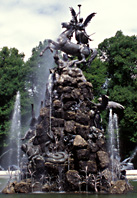 |
|
Another, unusual fountain in the Herreninsel park. |
|
 |
|
Sign for the Konigssee - Bodensee Radweg (bike itinerary), not far from the Inn River.. |
|
 |
|
View of the plain near the Inn River. |
|
 |
|
The Schillersee at dusk. |
|
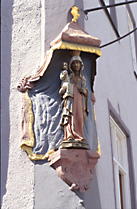 |
|
Statue seen in the resort town of Bad Tolz. |
Organizing the Trip Yourself:To print itinerary, select the text below, and choose print selection.Please follow this link for an explanation of the author's traffic ratings.Starting Point: Salzburg, Austria, accessible by train via Munich or Italy, or via air. Ending Points: Prien a Chiemsee, Munich, Bad Tölz, Garmisch-Partenkirchen, Füssen, Immenstadt i.Allgäu, or Lindau—all in Germany; or in Innsbruck, Austria. Distance and time (without side trips): 102 kilometers to 396 kilometers; one to two weeks . Rentals: Bring your own bicycle or consider renting in Munich and carrying your bike to the starting point on the train. The following company claims to rent 24 speed aluminum frame bikes suitable for a bike tour: Radius Tours and Bikes, e-mail radiusmunich@t-online.de.site: http://www.radius-munich.com. Accommodation and Restaurants: Prices of hotels for 2 range from modest in Guest Houses and Pensions (about €35 per day, with a supplement of € 3 or €4 if the stay is only one night), to €100 in fancy resort hotels or city business hotels. Campground high-season prices range from €4.50 to €7.00 per adult. For campgrounds in Austria, see this site: http://www.campsite.at/En. For campgrounds in Bavaria, start with the commercial site: http://www.camping-germany.eu.com, but you may find a better choice by contacting the tourist offices listed below. Your cost to eat in a pleasantly decorated restaurant serving typical regional cuisine, including a glass of wine or beer, will range from €12 to €16 per person. Fancier restaurants will cost more. Breakfast is normally included in the price of the hotel. Service charges are also included, but you may wish to give a small extra tip for excellent service. In many resort towns hotel space is very tight in August, and you may find no availability, or be forced into a higher price category or to less desirable hotels. In Bavaria and this part of Austria, local tourist offices typically know what space is available in their town. You may want to drop in to the local tourist office before looking for a last minute hotel. It can be wise to call ahead to the local tourist offices in towns where you may spend the night, and then call hotels one or two days in advance. The following is a partial list of local tourist offices (in German "Touristinformation", or "Verkehsamt" (When calling from out of a country, dial 001 from the USA or 00 in Europe + the country code (43 for Austria, 39 for Germany), and the phone number—without the initial 0):
In Munich, the tourist office at the main railroad station provides a mullti-page booklet for €1 containing a list of several hundred hotels. To make train reservations by telephone within Germany, the phone number is 0180-5996633. Maps and Guidebooks: By all means obtain the relevant ADFC (German Bicycle Touring Club) maps, available in the USA online at www.omnimap.com, or in bookstores in Germany or in nearby Austria. For the part of the trip that includes Salzburg, Berchtesgaden, and the Chiemsee, you need map #27, "Chiemsee/Inn/Salzkammergut". For the Inn River valley, Bad Tolz, Innsbruck, Fussen and Munich, you need map #26, "Oberbayern/ München". For the trip from Fussen to Lindau on the Bodensee, you need map #25, "Bodensee/Schwäbische Alb". The ADFC maps are at a scale of 1:150 (1 cm = 1.5 km). They show the best roads for biking and most of the bike paths. They indicate moderate and steep slopes. In short, they are essential. They do, however, have some problems: first and foremost, distances are rarely given, leaving it to you to estimate how far you will bike. Some of your estimates are likely to be off the mark. Secondly, they do not show the names of all of the bike routes, which can make it much harder to follow the correct route, since you won't know which signs to follow. You might want to obtain the German language guide booklet "Inn Radweg 2" from http://www.Esterbauer.com if you are riding to Innsbruck along the Inn River (and also information on the Chiemsee). This has 1:50,000 maps and information on the towns traversed. (In the other direction it provides information on the Inn River bike path as far as Passau, the confluence with the Danube and the Danube bike path, described elsewhere on this site.) You may also wish to carry a general tourist guidebook for Bavaria. Bike Routes: Despite its name, the Bodensee - Königssee Radweg (bike route) does not run all the way from the Bodensee to the Konigsee. ("See", pronounced "zay", of course, means "lake" in German. The Bodensee is known as Lake Constance in English. The route runs only from the Bodenzee to the southwestern edge of the Chiemsee (pronounced as though spelt "kiemzay"). Some bike routes in eastern Bavaria, which are signposted, do not appear on editions of the ADFC bicycling maps! Tip: Very few, if any, tourists in Bavaria (or elsewhere) get started before 9:00 AM; the first sightseeing busses arrive around 10:00 AM; and the mad-rush starts about 11:00 AM. Tip: General information on cycling in Germany and commercial tours, for those who are fluent in the German language, is available from: http://www.adfc.de. Itineraries: All routes: From Salzburg, Austria to Prien a Chiemsee, Germany via Berchtesgaden: 102 kilometers. Train connection in Prien, or continue. 2 nights (or more) in Salzburg; 2 nights (or more) in Berechtesgaden; 2 nights on the Chiemsee at one or a combination of Chieming, Seebruck or Prien. In Salzburg, one tourist office is at the train station, another at Mozart Platz (place) one block from the river below the fort and near the cathedral. The tourist office distributes a free regional bicycle map. There are two good routes out of Salzburg towards Berchtesgaden: The shortest one is to cross west from the old city through the pedestrian-biking tunnel in the hillside just north of the Festspielhaus (Festival Playhouse). You emerge to a bike lane by the sidewalk; the road turns slightly right (do not turn sharply right). Continue to the second (?) stoplight, and turn left on Moonstrasse (bike lane). Follow this straight for several kilometers until you eventually cross the autobahn superhighway. Take the next left and follow into Grödigl. Now, bearing right, follow signs to St. Leonhard. You will intersect highway B160, where you turn right. With a very short exception, a sidewalk bike way or a wide shoulder "bikelane" goes all the way to Berchtesgaden, about 27 kilometers from Salburg. The other route follows a bike path along the west bank of the Salzach river south from Salzburg. Just after crossing over the autoroute(before a little stream) turn right on a road near the stream. Cross highway B159 and continue to St. Leonhard. Turn left on B160, and continue as above to Berchtesgaden. The Berchtesgaden Tourist Office provides an excellent map of the area, and is very helpful in finding lodgings. There are two possible general routes from Berchtesgaden to the Chiemsee: The first, via highway 305 and 306 direct to Siegsdorf is more hilly, and runs through narrow mountain valleys. It bypasses several interesting areas, and is not shown as being good for cycling by the ADFC map. The second route follows highway B20. If you are starting from the center of Berchtesgaden, you can just continue on Mazimilian Strasse, which later joins B20. When the bicycle lanes end along the highway, you sometimes have the choice of taking detours on side roads or riding on the main highway. At one point the bike lane angles off to the right behind a small lake. At the first Y you bear right (the left branch goes to the house) and ride on gravel and dirt roads through the forest; although slower, this was very pleasant. When you emerge from the woods, on a paved bicycle path alongside the road, as you ride down hill you will come to a Y in the path. The left branch is for Bad Reichenhall, the right one for Gmain (and Marzoll?). Even though it is slightly longer, the left branch into Bad Richenhall passes through the scenic town, while the right branch leads to a maze of unmarked roads where you can not help but get badly lost. You curve to the Northeast, along a lake and the Saalach river. You cross this on a bridge, following something called the Saalinen-Radweg, there are signs with "Salz" as their major label as far is Traunstein. If you should become lost along the river, ask cyclists for directions to Pidding. From Pidding, ride to Anger, to near Teisendorf, and then via Wolf and Lauter to Traunstein. Some of the riding is on gravel paths, and some in over rolling hills, but unless time is a key element, you will find these byways much more rewarding than the highway. From Traunstein, all the main bike routes all follow the south shore of the Chiemsee. To be sure, this is substantially the shortest way, and it is entirely on bicycle paths, but the author rode, and suggests you ride, the northern shore, for three reasons: You don't ride beside the Autobahn expressway; you pass through several charming towns; and you have wonderful views of the lake framed by the Alps in the background. If you do decide to ride the northern shore, proceed west from Traunstein on minor roads to Chieming, or if time is short, via Nussdorf to Seebruck. You can choose, then, to follow either the lakeside gravel bike path, or the adjacent road bearing light to moderate traffic. Continuation from Prien am Chiemsee
Continuation from Bad Tölz
Continuation from Eschenlohe
Continuation from Füssen
|